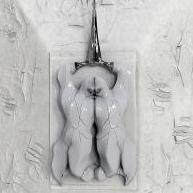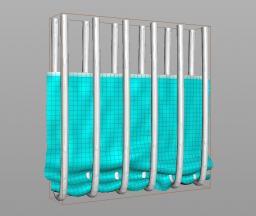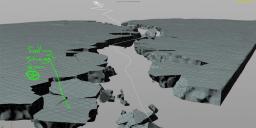
sim
Members-
Posts
31 -
Joined
-
Last visited
sim's Achievements
Newbie (1/14)
3
Reputation
-
Hi all, I've got a motion editing setup happening, but it gets really slow heavy at certain nodes. I was wondering if anyone here could have a look and point out any efficiency gains I could be making? I've been figuring out a workflow for doing motion editing (animation) of my mocap that gets transferred to a metahuman. (Because of issues I was having with Houdini'd retargetting, I ended up doing the basic retargetting in Maya. But I'm doing the motion editing in Houdini) It's all working well - Thanks to madebygeoff for getting me started - I have all the basics in there; fingers and posture correction. I've also got a constraint setup for locking/controlling the right hand. But when I start using it - by turning the blend from 0% - 100%, my framerate drops a great deal - The arm constraint is very heavy when I do use it. Hoping someone here could have a look and make a suggestion or two. I've attached my hip file, plus an example fbx to plug in to the top. 'cheers, Sim MotionEditing_TEST.hip seq_01_t3_Sup.fbx
- 1 reply
-
- rig
- constraints
-
(and 3 more)
Tagged with:
-
motion editing - hand and leg ik constraint pinning.
sim replied to sim's topic in Animation & Rigging
Hey Geoff, that is... absolutely awesome!! Thankyou so much for that. It's helped me out going through your explanation and that hip file you provided. I've wrapped my head around it. Happy to say it makes sense. But I was a long long way from getting to that kind of solution myself. (I'm off now to get comfortable with Rig Attrib VOPS.) I've learnt. Thanks. -Sim- 3 replies
-
- motion capture
- motion editing
-
(and 3 more)
Tagged with:
-
Hi all, I've looked - but I can't figure out how to pin a hand in Houdini using Kinefx. I've got two situations: -My input motion capture has a person holding a mobile phone with both hands - I need to pin one of the hands to the other hand as they walk around so it looks like both hands are properly holding the phone. -Also some of my motion capture has a bad arm that twitches erratically at times. I'd like to pin the hand of that arm at those times and bypass the twitch. Does anyone have a suggestion of how to go about this. Or point me to where there's good info on this. Coming from Nuance, Motionbuilder, and Maya, what I'm looking for is referred to as pinning (or 'hand/foot constraint pinning') Can't find anything here in Houdini around those terms. -Sim
- 3 replies
-
- motion capture
- motion editing
-
(and 3 more)
Tagged with:
-
I know one can do just about anything in Houdini, so really my question is: can this be done in a non-'insanely difficult' way? I'd love to try and set up a walking treadmill simulation. The idea is that a character starts from standstill to a walk and then to a run. And then just for fun the treadmill inclines upwards so the character ends up running up a slope. I'm hoping to make the treadmill react to the character. It works to keep the character stationary - however the character moves. I'm thinking I might be able to make use of the crowd agent toolset. As I understand it, each individual is a particle. Perhaps the treadmill can read the forces that motivate the particle and apply an equal opposite force to keep the particle 'stationary'. (Visually represented as a treadmill.) And the other thing I was hoping to leverage from the crowd tools is the terrain adaptation. So that the character's feet would adjust to the treadmill as it inclines upwards, and also leaning the torso forward to keep the character upright. Am I on the right path here? Is there perhaps a better alternative? I'm open to any suggestions. Character animation and crowds is not a part of Houdini I've spent much time in. 'regards, Simeon
-
gathering a cloth sail with ropes, very slow - sure there's a bett
sim replied to sim's topic in General Houdini Questions
Hey, I just wanted to update here and mention that I changed my collision geometry from the curved tubes you see above to extruded boxes. The box was extruded along a path much like a 'V' with a little flat section at the bottom. The end result is pretty much identical to the image above - however no curved surfaces. The sim times are much, much faster. Didn't change anything else. -Sim -
Hi all, I'm doing a simulation of a cloth sail being gathered up. In real life, and in the final render, it would be done with ropes that loop around the bottom of the sail and pull it together. For my testing, I'm using thick 'hooks' that pull the cloth upwards. It sims verryyy slowly. I'm sure there must be a better way. I'm open to suggestions and I've included my file if anyone would like to take a look. I feel like I ought to be considering an entirely different type of collider. A point or wire collider - if those exist? In the dopnetwork I'm bringing the hooks in as a 'staticobject' that I've also pre-converted to a volume and using as a 'proxy volume' in the Collisions - Volume tab. Most other settings I've left at their defaults. The hooks are as thick as they are because I found that thinner ones kept passing through the cloth. 'regards, Sim cloth_hook_01.hipnc
-
Hi, here's the file. I cut out everything else that wasn't related to the smoke sim. And unfortunately the geo that feeds the sim is too large to include here. But it does show my setup and all the settings I've used. -Simeon smoke_cluster_01.hip
-
Hi all. I've been learning much about smoke sims in the last few weeks. I have here a smoke test and I'd like to improve it. There's a number of issues going on here, but the first one I'd like to get to the bottom of is the way the smoke is popping (pops) into existence. In the clip below, the popping starts happening 3sec in, but you can particularly see it from 8secs onwards. Solid blocks of smoke appearing before they start dispersing - way too rapidly. So what's happening is that I have a large (110, 3, 60) voronoi fractured terrain that suddenly cracks all the way through the middle and then starting from the camera pieces start falling away. I'm using a 'delete' sop that's deleting geometry that isn't moving (v<0.9). So the blocks of smoke that suddenly appear are when the terrain pieces start falling fast enough to go into the smoke source. And the smoke sim is a cluster system with ten points. But it's too sudden and strong, how can I make them fade in? I'd appreciate it if anyone could give some input on this and on any of the other issues I'm seeing in this smoke test. (Other issues being the stair stepping in the close to camera smoke, and that the turbulence and dispersion? seems much too high. I'd like to slow the smoke down a lot.) 'cheers, Simeon
-
I'm sure this is simple, but I can't figure it out. I have a destruction sim of ground falling away. I'm now adding smoke to this. For the fuel source I am deleting the geometry based on velocity, so that only moving points of the geo remain to be fuel. But now I'd like to put down a point attribute that lists the frame that a point comes into existence? I've tried using an attribVOP with an 'if' block inside. For the 'if' condition I use a 'compare' of the 'frame' attribute itself. If It's zero, then go ahead and change it, otherwise leave it alone. (Is what I think my logic is doing.) But this isn't working. I've attached here a very simple setup showing what I've tried to do. Currently it's failing and writing the current frame number to every single point. I'd appreciate any help. -Simeon startFrameAttribute_01.hip
-
inherit point velocity problem with packed rbds - causes a jump
sim replied to sim's topic in General Houdini Questions
That's awesome. Thank you. I was so close, (But no cigar.) Looking at 'fractureTesting_04_post_2.hipnc' - the important things was to move the velocity transfer to after the assemble sop. And then in the rbdPackedObject to 'inherit velocity from point velocity', but turn off 'Create Active Object'. I read the description of the 'Create Active Object'. It kinda makes sense. The way I've interpret it is that when it's ticked, all the objects inheriting velocity will move on the the first solving frame before the popwrangle node can make them all inactive again? Thanks again, Simeon -
Hi all, when I use 'Inherit Velocities' on the rbdPackedObject in my sim, the pieces all jump (or pop) to a different position based on their velocities in the first solve frame - Frame 2. I'm trying to get better control of the exploding animation of my fractured rbd object. I came across the qlib destruction example recently and have been modifying my setup to use their method. It involves putting velocities onto the fractured object before it goes into dops. I like the controllability of this. I've spent all day trying to find a way to get those velocities on my pieces without the initial pop/jump happening. I've attached my testing file. Any help would be greatly welcomed. By me -Sim fractureTesting_04_post.hipnc
-
Hey those are both great ideas. Pavel, I tried out your suggestion a few days ago. Thank you. Took me a while to understand how to do it, but I got there and I've definitely learnt along the way. The results I have are promising. Though I have to say I can't get the spring constraints to be very stable. I've played with strength, damping and mass. I can only use low values of strength, before pieces start popping to the ends of the universe on frame 2. So I use low strength, and quickly delete the spring constraint before the pieces start looking like they drooping away, and it's enough to start a tumble on most pieces. Travis, I'm not sure about the noisy point velocities - can't picture how that would give a tumble in the right direction/axis. But the random cubes placed right under pieces and deleted away just slower than the constraints. Brilliant! What a simple, but effective idea. I will post back with more results. Sim.
-
Hi all, I have an voronoi fractured terrain and in classic fashion, there's a crack through the middle and the pieces start falling from the central crack down into an abyss. To get the falling propagating outwards from the middle, I'm using a Glue network and dissolving the constraints outwards over time. My object is an RBD packed primitive . This all works, but the pieces tend to fall straight down as their constraints dissolve. I'd really like to get the pieces to tumble as they fall. So that just as the piece is about to fall , the exposed side closest to the abyss - starts to tilt down before the whole piece gives. I'm stuck at this. I've tried simple things like increasing friction. I know one way to do this would be to model a lip on the bottom of every piece facing the centre of the terrain. But doing that by hand would be prohibitive. Does anyone know how I could approach this? Sim.
-
find/locate exposed parts of voronoi fracture?
sim replied to sim's topic in General Houdini Questions
Hey thanks a lot. I remember looking at the debris tool a while ago out of curiosity, but didn't need it then time and promptly forgot about it. I've had a quick squiz, and it looks to be very close to what I'm looking for. -Sim -
Hi, Couldn't find anything on this, but I have a landscape that I've voronoi fractured. It's falling away piece by piece. I want to have sand (particles) falling from the edges of the exposed pieces. I know how to generate an edge attribute for each piece. But I'm hoping someone can help me with how I can find each exposed piece? -As pieces of the landscape drop away. New edges/primitives/points become exposed. How can I find these? I'd appreciate any input on this. -Sim




